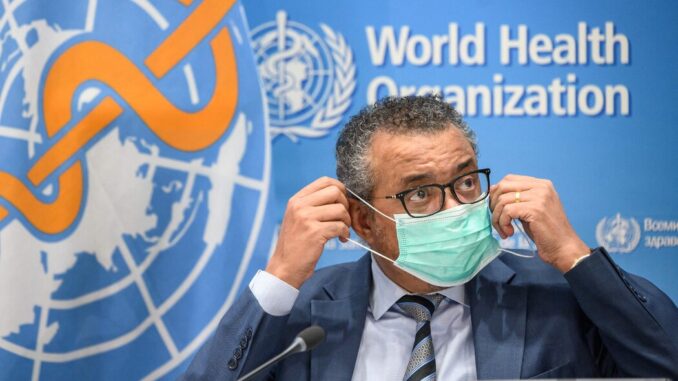
The World Health Organization (WHO) expects countries to sign new agreements that would give them sweeping authority to set global pandemic policy.
But they have not profided a clear consensus on what distinguishes pandemics from epidemics or endemic diseases.

BYPASS THE CENSORS
Sign up to get unfiltered news delivered straight to your inbox.
You can unsubscribe any time. By subscribing you agree to our Terms of Use
Latest Video
As the Member States of the World Health Organization (WHO) negotiate new agreements to centralize the management of pandemics with an annual budget of over $31.5 billion, it should be assumed that everyone was clear on what a pandemic actually is.
Yet this is not the case.
The Defender reports: Although countries will be voting in two months on a new Pandemic Agreement and amendments to the International Health Regulations (IHR) to grant the WHO wide authority over pandemic management, there is no universally agreed definition of “pandemic.”
What degree of severity is required? How widespread must it be? What proportion of the population must be at risk?
An outbreak of common cold crossing borders fits many pandemic definitions, as does a repeat of the medieval Black Death.
International agreements are normally formed around a definable problem, but the world is about to invest tens of billions without a solid basis to predict costs and benefits.
In other words, there is no clear agreement on what the World Health Assembly is actually agreeing to.
A history of pandemics
When we now speak of a pandemic, we usually mean the global spread of SARS-CoV-2 that began in 2019.
The word evokes images of empty streets and closed markets, of masked faces and silent people standing six feet apart.
This drives the sense of urgency that policymakers are currently responding to through the design of new pandemic documents.
Many Pandemic Prevention, Preparedness and Response (PPPR) documents suggest that these policies are an essential response by claiming a 50% chance of a COVID-19-like pandemic in the next 25 years or referring to the economic costs of COVID-19 to support claims of return on investment.
This approach is problematic as it fails to distinguish between the direct costs of the disease and the effects of the very unusual response.
The etymology of the word “pandemic” comes from the ancient Greek root dêmos (δῆμος, people, populace) with the related “epidemic” and “pandemic.”
The prefix pan- (ancient Greek πάν) generally means all or every; thus, pandemic is derived from the ancient Greek concept πάνδημος (of or belonging to the whole people, public).
The term usually refers to infectious diseases, although some use of pandemic can be more broadly colloquial, for example speaking of a “pandemic of obesity.”
What distinguishes pandemics (and epidemics) from endemic diseases is that they affect a large number of people in a relatively short time span and in excess of normal expectancy.
What sets pandemics apart from epidemics in people’s minds is a wider geographic spread across national borders.
Some of the worst pandemics recorded in history followed the European conquest of the Americas, bringing new pathogens to an immunologically naïve population. Such conditions do not exist in today’s globalized world.
Other devastating pandemics were caused by bacteria like cholera or the plague, the latter being responsible for the Black Death in the 14th century that wiped out perhaps a third of the European population.
Improved sanitation and the discovery of antibiotics have since fundamentally reduced the threat of bacterial infections, once the main driver of pandemics.
The last major pandemic the world faced before COVID-19 was the Spanish flu of 1918. Accordingly, up until the COVID-19 pandemic, “pandemic preparedness” almost universally referred to influenza pandemics.
The WHO published its first influenza pandemic plan in 1999, motivated by the first recorded human infections with avian flu H5N1.
The plan was updated several times, the last time in 2009 and defines several “pandemic phases.”
These constitute the only pandemic definitions the WHO has published in official guidance and remain specific to influenza.
The swine flu controversy
When the WHO declared the H1N1 Swine flu a pandemic in 2009, despite it being no more severe than normal seasonal influenza, a controversy erupted over what defines a “pandemic.”
While the WHO’s pandemic plan had always focused on the spread of a novel subtype of influenza without requiring it to be extraordinarily severe, a definition on the WHO’s website read for six years:
“An influenza pandemic occurs when a new influenza virus appears against which the human population has no immunity, resulting in several simultaneous epidemics worldwide with enormous numbers of deaths and illness.”
In response to a query by a CNN journalist questioning the need for a condition of “enormous” severity, the definition of pandemic influenza on the WHO homepage was changed in May 2009, removing the phrase “with enormous numbers of deaths and illness.”
Instead, the new definition clarified that “pandemics can be either mild or severe in the illness and death they cause, and the severity of a pandemic can change over the course of that pandemic.”
Although the definition on the website had no practical effects, the fact that the change happened shortly before declaring Swine flu a pandemic raised suspicion.


